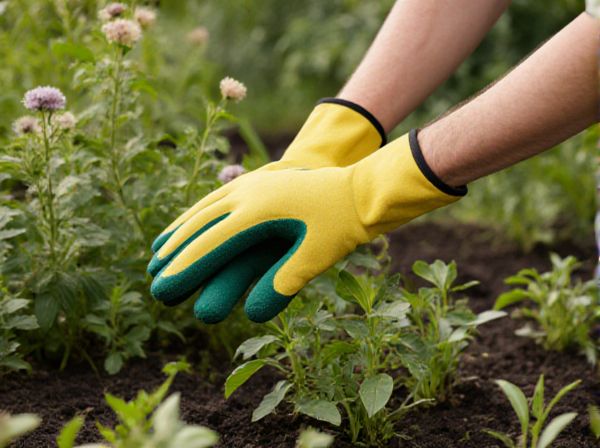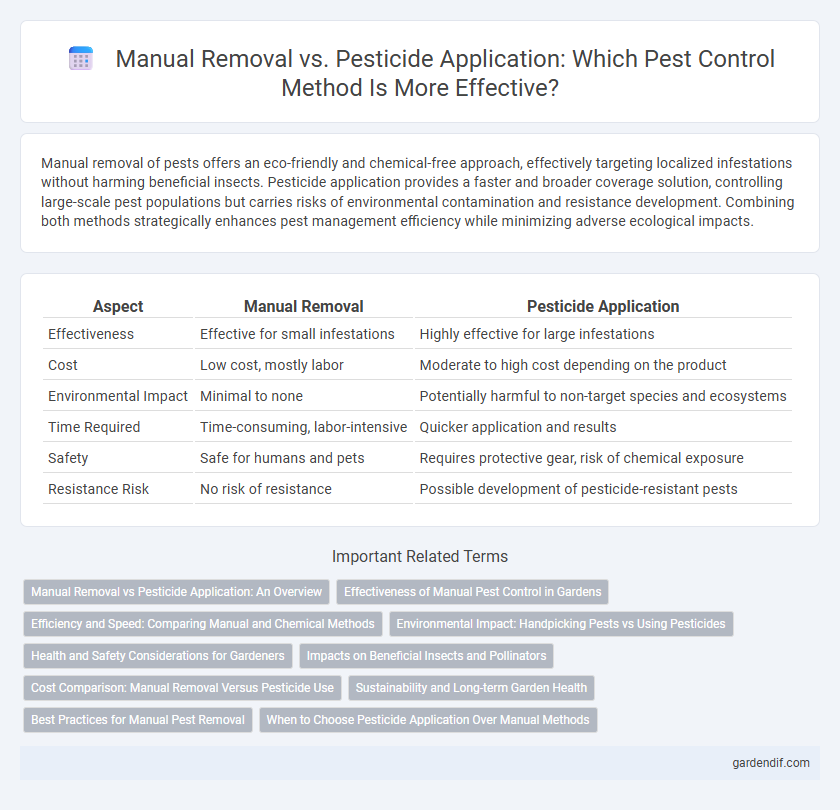
manual removal vs pesticide application Illustration
Manual removal of pests offers an eco-friendly and chemical-free approach, effectively targeting localized infestations without harming beneficial insects. Pesticide application provides a faster and broader coverage solution, controlling large-scale pest populations but carries risks of environmental contamination and resistance development. Combining both methods strategically enhances pest management efficiency while minimizing adverse ecological impacts.
Table of Comparison
| Aspect | Manual Removal | Pesticide Application |
|---|---|---|
| Effectiveness | Effective for small infestations | Highly effective for large infestations |
| Cost | Low cost, mostly labor | Moderate to high cost depending on the product |
| Environmental Impact | Minimal to none | Potentially harmful to non-target species and ecosystems |
| Time Required | Time-consuming, labor-intensive | Quicker application and results |
| Safety | Safe for humans and pets | Requires protective gear, risk of chemical exposure |
| Resistance Risk | No risk of resistance | Possible development of pesticide-resistant pests |
Manual Removal vs Pesticide Application: An Overview
Manual removal targets pests directly, minimizing chemical exposure and environmental impact while requiring consistent effort and skill for effective control. Pesticide application offers rapid and broad-spectrum pest suppression but poses risks including resistance development, non-target species harm, and potential health hazards. Selecting between these methods depends on infestation severity, pest type, and long-term sustainability goals.
Effectiveness of Manual Pest Control in Gardens
Manual pest control in gardens offers targeted removal of pests, significantly reducing infestations without harming beneficial insects or the environment. This method is particularly effective for small-scale gardens and early-stage pest problems, enabling gardeners to maintain plant health through hands-on monitoring and intervention. While less efficient for widespread infestations, manual removal minimizes chemical exposure and supports sustainable gardening practices.
Efficiency and Speed: Comparing Manual and Chemical Methods
Manual removal of pests provides targeted control but is often time-consuming and labor-intensive, making it less efficient for large infestations. Chemical pesticide application offers rapid action and broad coverage, significantly increasing the speed of pest elimination in extensive areas. Efficiency in pest management is enhanced through chemical methods, though manual removal remains preferred for small-scale or environmentally sensitive situations.
Environmental Impact: Handpicking Pests vs Using Pesticides
Handpicking pests reduces chemical contamination in soil and water, preserving biodiversity and promoting natural pest control. Pesticide application often leads to harmful residue buildup, affecting non-target species and disrupting ecosystems. Manual removal supports sustainable agriculture by minimizing environmental hazards associated with toxic chemicals.
Health and Safety Considerations for Gardeners
Manual removal of pests minimizes exposure to toxic chemicals, reducing health risks like skin irritation and respiratory issues for gardeners. Pesticide application requires strict adherence to safety guidelines, including protective clothing and proper ventilation, to prevent poisoning and long-term health problems. Choosing manual methods promotes a safer gardening environment, particularly for those with allergies or sensitivities to chemical agents.
Impacts on Beneficial Insects and Pollinators
Manual removal of pests minimizes harm to beneficial insects and pollinators by selectively targeting only unwanted species, preserving natural ecological balance. Pesticide application often leads to collateral damage, reducing populations of essential pollinators like bees and butterflies, which can disrupt pollination services crucial for many crops. Protecting beneficial insect communities enhances biodiversity and supports sustainable pest management strategies.
Cost Comparison: Manual Removal Versus Pesticide Use
Manual removal of pests typically incurs higher labor costs but eliminates chemical expenses and reduces environmental impact, making it a cost-effective method for small infestations. Pesticide application often requires less time and immediate effectiveness but can lead to higher long-term expenses due to potential health risks, environmental damage, and repeated treatments. Analyzing the total cost of manual removal versus pesticide use involves assessing direct expenses, environmental impact, and potential health consequences.
Sustainability and Long-term Garden Health
Manual removal of pests promotes sustainability by minimizing chemical use and preserving soil microbiota integrity essential for long-term garden health. Consistent handpicking or trapping targets specific pests, reducing environmental contamination and resistance development often caused by pesticide application. Over time, integrating manual removal supports biodiversity, enhances plant resilience, and fosters a balanced ecosystem crucial for sustainable garden ecosystems.
Best Practices for Manual Pest Removal
Manual pest removal is most effective when targeting localized infestations of insects like aphids and caterpillars, using tools such as gloves, tweezers, or vacuum devices to minimize damage to plants. Regular inspection and immediate removal reduce pest populations without harmful chemical residues, preserving beneficial insects and soil health. Integrating manual removal with cultural controls like pruning and habitat management enhances sustainable pest control in gardens and small-scale farming.
When to Choose Pesticide Application Over Manual Methods
Pesticide application is recommended when pest infestations are widespread, posing significant risks to crops, health, or property that manual removal cannot efficiently manage. Large-scale infestations of insects such as aphids or termites often require targeted chemical treatments to quickly reduce populations and prevent further damage. Choosing pesticides becomes essential when rapid control is necessary, the pest species reproduces quickly, or manual methods are impractical due to the pest's location or numbers.
manual removal vs pesticide application Infographic

 gardendif.com
gardendif.com